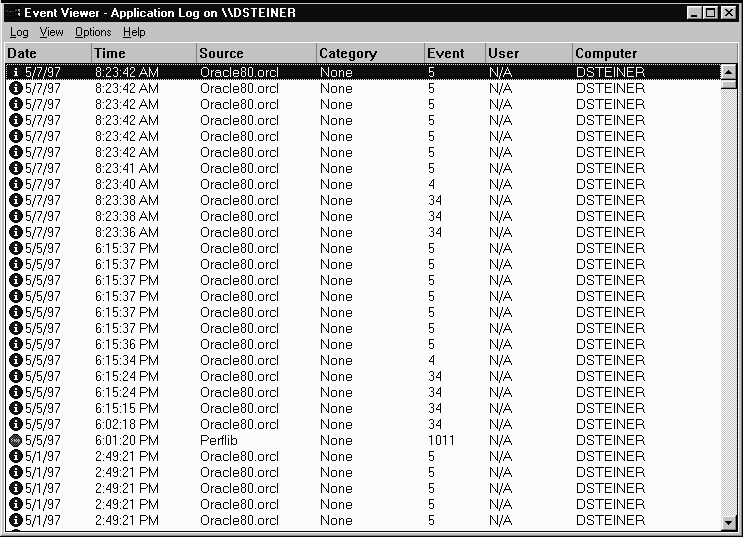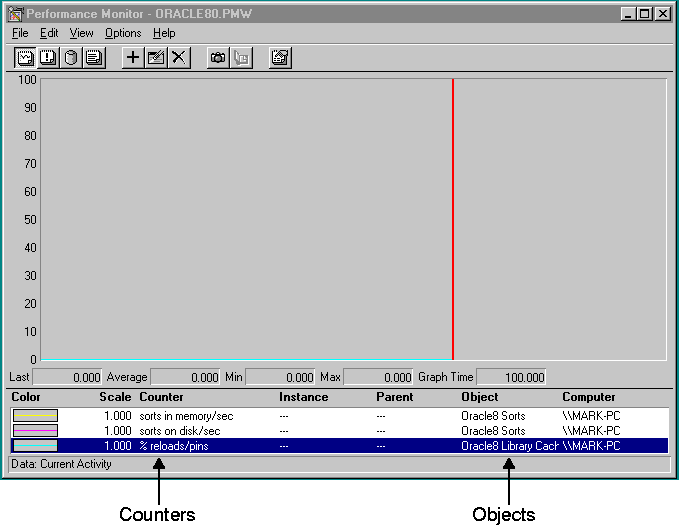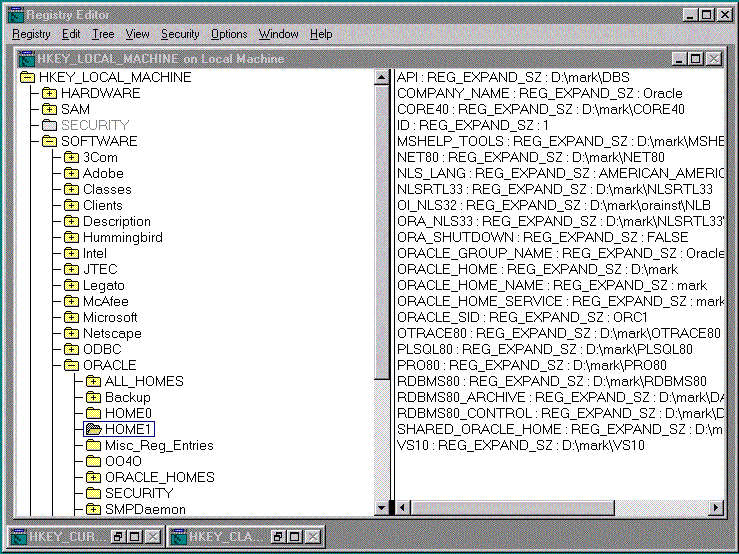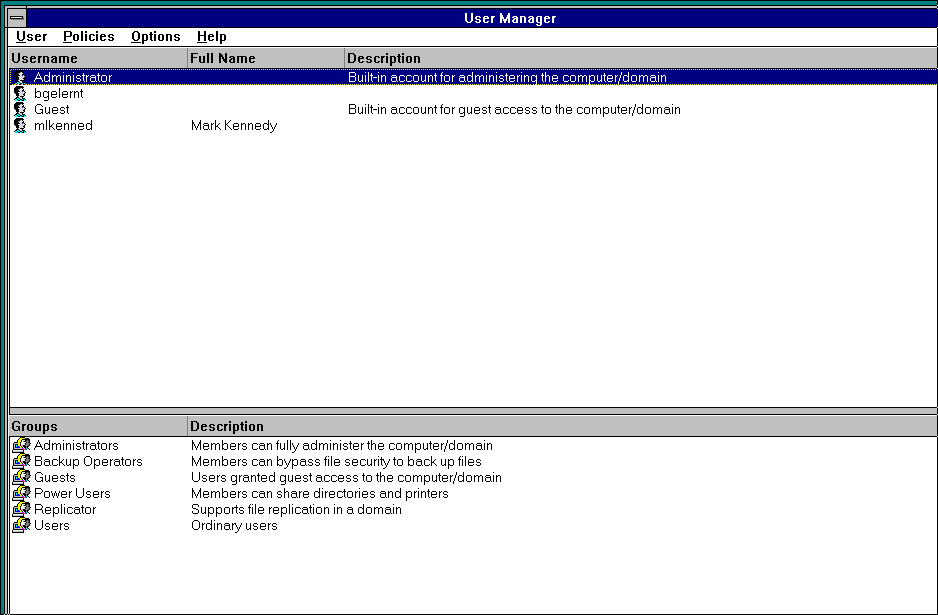Release 8.0.4 for Windows NT
A55928-01
Library |
Product |
Contents |
Index |
| Oracle8 Enterprise Edition Getting Started Release 8.0.4 for Windows NT A55928-01 |
|
Oracle8 Enterprise Edition includes various tools to perform database functions. This chapter describes the preferred tools to perform common database administration tasks.
Specific topics discussed are:
Database tools is a collective term for tools, utilities, and assistants that you can use to perform database administration tasks. Some database tools perform similar tasks, though no one database tool performs all database administration tasks. The following sections indicate which database tools can be used on particular operating systems and the preferred tools to use for common database administration tasks.
This table lists database tools and the operating system(s) on which each can be used:
| Database Tools | Oracle8 Enterprise Edition for Windows NT | Oracle8 Client for Windows NT | Oracle8 Client for Windows 95 |
|---|---|---|---|
|
Oracle8 Utilities |
|
|
|
|
DBVERIFY (DBVERF80) |
Yes |
Yes |
Yes |
|
Export Utility (EXP80) |
Yes |
Yes |
Yes |
|
Import Utility (IMP80) |
Yes |
Yes |
Yes |
|
Migration Utility (MIG80) |
Yes |
No |
No |
|
NT Backup Manager1 |
Yes |
No |
No |
|
NT Recovery Manager |
Yes |
No |
No |
|
OCOPY80 |
Yes |
Yes |
Yes |
|
ORADIM802 |
Yes |
No |
No |
|
Password Utility (ORAPWD80)3 |
Yes |
No |
No |
|
Recovery Manager (RMAN80) |
Yes |
Yes |
Yes |
|
Server Manager (SVRMGR30)4 |
Yes |
Yes |
Yes |
|
SQL*Loader (SQLLDR80) |
Yes |
Yes |
Yes |
|
TKPROF (TKPROF80) |
Yes |
Yes |
Yes |
|
Windows NT Tools |
|
|
|
|
Control Panel |
Yes |
Yes |
No |
|
Event Viewer |
Yes |
Yes |
No |
|
Performance Monitor |
Yes |
Yes |
No |
|
Registry |
Yes |
Yes |
Yes |
|
User Manager |
Yes |
Yes |
No |
|
Oracle Enterprise Manager |
|
|
|
|
Backup Manager |
Yes |
Yes |
Yes |
|
Data Manager |
Yes |
Yes |
Yes |
|
Instance Manager |
Yes |
Yes |
Yes |
|
Schema Manager |
Yes |
Yes |
Yes |
|
Security Manager |
Yes |
Yes |
Yes |
|
SQL Worksheet |
Yes |
Yes |
Yes |
|
Storage Manager |
Yes |
Yes |
Yes |
|
Oracle Assistants |
|
|
|
|
Oracle Data Migration Assistant |
Yes |
No |
No |
|
Oracle Database Assistant |
Yes |
No |
No |
|
Oracle INTYPE File Assistant |
Yes |
Yes |
Yes |
|
Oracle Migration Assistant for Microsoft Access |
Yes |
Yes |
Yes |
|
Oracle Net8 Assistant |
Yes |
Yes |
Yes |
|
Oracle Net8 Easy Config |
Yes |
Yes |
Yes |
|
Oracle Patch Assistant |
Yes |
Yes |
Yes |
|
SQL*Plus |
Yes |
Yes |
Yes |
|
1
NT Backup Manager and NT Recovery Manager are Oracle Corporation products, distinct from the NT Backup Tool available with your Windows NT operating system. 2 ORADIM80 only operates on local databases. 3 ORAPWD80 does not work on password files for remote databases. 4 The ORADEBUG utility can be used through Server Manager to send debug commands to Oracle processes. See "Using the ORADEBUG Utility" in Chapter 10, "Administering a Database". |
This table lists common database administration tasks and the various database tools you can use to perform them. Oracle Corporation recommends you use the tools listed in the "Preferred Database Tool" column of the table. After choosing a tool to perform a task, go to "Starting Database Tools" in this chapter for instructions on how to start the tool.
| Database Administration Task | Preferred Database Tool | Other Database Tools |
|---|---|---|
|
Create a database |
Oracle Database Assistant |
|
|
Delete a database |
Oracle Database Assistant |
ORADIM80 and Server Manager (SVRMGR30) together |
|
Delete a database service |
Oracle Database Assistant |
ORADIM80 |
|
Start a database |
Instance Manager1 |
|
|
Shut down a database |
Instance Manager |
|
|
Change internal database passwords |
ORAPWD80 |
ORADIM802 |
|
From release 7.x to release 8.0.4 |
Oracle Data Migration Assistant |
Migration Utility (MIG80) |
|
From release 8.0.3 to release 8.0.4 |
Oracle Data Migration Assistant3 |
Run provided scripts in Server Manager |
|
Export data |
Data Manager |
Export Utility (EXP80) |
|
Import data |
Data Manager |
Import Utility (IMP80) |
|
Load data |
Data Manager |
SQL*Loader (SQLLDR80) |
|
Back up a database |
Backup Manager |
|
|
Recover a database |
Backup Manager |
|
|
Authenticate database administrators and users |
Security Manager |
|
|
Grant database roles |
Security Manager |
User Manager |
|
Create database objects5 |
Schema Manager |
|
1
Instance Manager can start up and shut down a database and perform other limited functions. This tool cannot be used to create database services, or create and delete databases. Instance Manager is an Oracle Enterprise Manager tool. 2 ORADIM80 can only set a password when none was previously set. Also, ORADIM80 can change a password by deleting and recreating the Oracle8 services. 3 Oracle Data Migration Assistant can only be used to upgrade release 8.0.3 databases to release 8.0.4. It cannot be used to upgrade an earlier Oracle7 database release to a later Oracle7 database release. See your Oracle7 for Windows NT documentation for information on how to upgrade from an earlier Oracle7 release to a later Oracle7 release. 4 Do not back up files while you are shutting down the database, otherwise your backup will be invalid. You cannot use an invalid backup to restore files at a later date. 5 See Oracle8 Administrator's Guide for guidelines on creating databases objects. In particular, see Appendix A, "Space Estimations for Schema Objects" which provides equations for estimating the space requirements for clusters, non-clustered tables, and indexes. Windows NT uses the same fixed header, transaction header, and row header constants described in that guide. |
This section describes how to start each of the database tools in the following categories:
You will be referred back to this section for database tool startup procedures as you use this manual.
If you are using multiple Oracle homes functionality, the command to start a tool includes [HOME_NAME] where [HOME_NAME] indicates the name of a different Oracle home. For example:
Start > Programs > Oracle for Windows NT - [HOME_NAME] > Oracle Database Assistant
If you want to start Oracle Database Assistant from an Oracle home called PROD, choose Start > Programs > Oracle for Windows NT - PROD > Oracle Database Assistant.

This table describes how to start each Oracle8 Utility, and where to go for further information on using these products:
| Oracle8 Utilities | To Start... | For More Information, See... |
|---|---|---|
|
DBVERIFY (DBVERF80) |
Enter the following at the MS-DOS command prompt: C:\> DBVERF80 DBVERIFY starts and prompts you for a file name parameter. To obtain a list of parameters, enter the following at the MS-DOS command prompt: C:\> DBVERF80 HELP=Y |
Oracle8 Utilities |
|
Export Utility (EXP80) |
Enter the following at the MS-DOS command prompt followed by your user name and password: C:\> EXP80 EXP80 starts and prompts you for parameters. To obtain a list of these parameters, enter the following at the MS-DOS command prompt: C:\> EXP80 HELP=Y Note: When running the Export utility, the default values for the following parameters under Windows NT are: Note: To export an entire database, you must use the user name SYSTEM. Do not use INTERNAL or SYS. |
|
|
Import Utility (IMP80) |
Enter the following at the MS-DOS command prompt followed by your user name and password: C:\> IMP80 IMP80 starts and prompts you for parameters. To obtain a list of these parameters, enter the following at the MS-DOS command prompt: C:\> IMP80 HELP=Y Note: When running the Import utility, the default values for the following parameters under Windows NT are: RECORDLENGTH 2 KB |
|
|
Migration Utility (MIG80) |
Enter the following at the MS-DOS command prompt: C:\> MIG80 |
|
|
NT Backup Manager |
Choose Start > Programs > Oracle for Windows NT - [HOME_NAME] > NT Backup Manager |
Online help included with this tool |
|
NT Recovery Manager |
Choose Start > Programs > Oracle for Windows NT - [HOME_NAME] > NT Recovery Manager |
Online help included with this tool |
|
OCOPY80 |
Enter the following at the MS-DOS command prompt: C:\> OCOPY80 |
|
|
ORADIM80 |
Enter the following with parameters at the MS-DOS command prompt: C:\> ORADIM80 PARAMETERS To get a complete listing of ORADIM80 parameters, enter a question mark preceded by a dash after the executable name: C:\> ORADIM80 -? Note: If you enter ORADIM80 without parameters at the MS-DOS command prompt, a GUI Instance Manager screen appears. This tool is no longer supported for use on Oracle8 Enterprise Edition. |
"Using ORADIM80" in this chapter |
|
Password Utility (ORAPWD80) |
Enter the following at the MS-DOS command prompt: C:\> ORAPWD80 FILE=FILENAME PASSWORD=PASSWORD ENTRIES=USERS where: |
Oracle8 Administrator's Guide, which describes how to use the Password utility |
|
Recovery Manager (RMAN80) |
Enter the following at the MS-DOS command prompt:
|
|
|
Server Manager (SVRMGR30) |
Enter the following at the MS-DOS command prompt: C:\> SVRMGR30 |
|
|
SQL*Loader (SQLLDR80) |
Invoke SQL*Loader at the MS-DOS command prompt followed by certain keywords. Enter the following and SQL*Loader displays a Help screen with the available keywords and default values: C:\> SQLLDR80 |
|
|
TKPROF (TKPROF80) |
Enter the following at the MS-DOS command prompt: C:\> TKPROF80 |
Oracle8 Tuning |
This table describes how to start each Windows NT tool, and where to go for more information on using these products:
| Windows NT Tools | To Start... | For More Information, See... |
|---|---|---|
|
Control Panel |
Choose Start > Settings > Control Panel |
|
|
Event Viewer |
Choose Start > Programs > Administrative Tools > Event Viewer |
|
|
Performance Monitor |
Choose Start > Programs > Oracle for Windows NT - [HOME_NAME] > Performance Monitor |
|
|
Registry |
Enter the following at the MS-DOS command prompt:
The registry editor window appears. |
|
|
User Manager |
Choose Start > Programs > Administrative Tools > User Manager |
|
You can start Oracle Enterprise Manager tools:
To start an Oracle Enterprise Manager tool separately:
For example Start > Programs > Oracle Enterprise Manager > Instance Manager.
The Login Information dialog box appears.
|
Additional Information:
See "Oracle Enterprise Manager" in Chapter 8, "Post-Installation Configuration Tasks" for information on configuration tasks you must perform before using Oracle Enterprise Manager and information on how to connect to an Oracle8 database. |
To start an Oracle Enterprise Manager tool from the Console:
The Login Information dialog box appears.
This table describes how to start each Oracle Enterprise Manager tool through the Console, and where to go for further information on using these tools.
This table describes how to start each assistant, and where to go for further information on using these products:
| Assistant | Choose Start > Programs > Oracle for Windows NT - [HOME_NAME] > | For More Information, See... |
|
Oracle Data Migration Assistant |
Oracle Data Migration Assistant |
|
|
Oracle Database Assistant |
Oracle Database Assistant |
|
|
Oracle Migration Assistant for Microsoft Access |
Oracle Migration Assistant for Microsoft Access |
|
|
Oracle Net8 Assistant |
Oracle Net8 Assistant |
|
|
Oracle Net8 Easy Config |
Oracle Net8 Easy Config |
|
|
Oracle Patch Assistant |
Oracle Patch Assistant |
"Downloading Patches from Oracle Worldwide Customer Support" in Chapter 10, "Administering a Database" |
This table describes how to start SQL*Plus, and where to go for further information on using this product:
| SQL*Plus | To Start... | For More Information, See... |
|
|
Enter the following at the MS-DOS command prompt: C:\> SQLPLUS Choose Start > Programs > Oracle for Windows NT - [HOME_NAME] > SQL*Plus 8.0 Starts the GUI version of SQL*Plus |
|
This table describes the ORADIM80 commands and parameters. Note that each command is preceded by a dash (-).
This section describes Windows NT specific information for using SQL*Loader (SQLLDR80).
These are the possible values for the Operating System Dependent (OSD) file processing specifications string option, referred to in the "SQL*Loader Control File Reference" chapter of Oracle8 Utilities.
| Processing Option | Description |
|---|---|
|
""1 |
Stream record format in which each record is terminated by a newline character. The maximum record size is 48 KB. |
|
"FIX n" |
Fixed record format in which each record is exactly n bytes long. If the record is terminated by a newline character, the newline character must be the nth byte. |
|
"VAR xxxx" |
Load variable length records. Specify the OSD "VAR recsizehint" in the control file for this option to take effect. The xxxx gives an estimate of the average record size to SQL*Loader so that it can approximate buffer sizes accurately and not waste memory. The default length is eighty characters. The xxxx does not specify how many leading bytes of length are included in each record. It only acts as a hint to SQL*Loader. Each record must always be preceded by five ASCII bytes containing the length of the remainder of the record. For example, a record must look like the following: 00024This is a 24 byte string Any whitespace, carriage returns, or linefeeds at the end of the record are ignored unless specifically included in the byte count in the length field. |
|
1
Two double quote characters with no space in between. |
SQL*Loader includes a direct path option that bypasses Oracle8 Enterprise Edition redo log and data verification features, thereby decreasing loading time. Use the direct path option with data files known to be error free.
When preparing a SQL*Loader control file (.CTL), you must follow certain syntax and notational conventions. When specifying datatypes in the SQL*Loader control file, note that the default size of native datatypes are specific to Windows NT. You cannot override these defaults in the control file.
| Native Datatypes | Default Field Length |
|---|---|
|
DOUBLE |
8 |
|
FLOAT |
4 |
|
INTEGER |
4 |
|
SMALLINT |
2 |
|
Additional Information:
For a complete list of options and instructions on using SQL*Loader, see Oracle8 Utilities. The directory ORACLE_HOME\RDBMS80\LOADER contains a number of examples on the use of SQL*Loader. |
The following Windows NT tools can be used to administer an Oracle8 database:
The Control Panel enables you to modify system options such as computer services. A service is an executable process registered in the registry and administered by Windows NT. The registry automatically tracks and records security information for each service you create.
When you install the Oracle8 database and other products, Oracle services are created and displayed in the Services dialog box:

Use the Services dialog box to start, stop, pause, or continue each of the Oracle services available on the computer, and to pass startup parameters to the service.
Oracle services are the same as Windows NT services. In order to connect to and use an Oracle instance, an Oracle service is created during the database creation process and associated with the Oracle8 database
Once a service is created with your Oracle8 database, the service can run even while no user is logged on. This is because your Oracle8 database starts each instance as a service. This feature enables you to maintain workstation security while running your Oracle8 database.
You can now have multiple, active Oracle home directories on a single computer. This affects the naming conventions for Oracle services. See "Managing Oracle Services" in Chapter 10, "Administering a Database" and Chapter 6, "Using Multiple Oracle Homes" for additional information.
|
Additional Information:
See Chapter 10, "Administering a Database", for specific instructions on using the Control Panel to start and stop Oracle8 database services. See also "Step 1: Start Oracle Services on Managed Oracle8 Database" in Chapter 8, "Post-Installation Configuration Tasks", for specific instructions on using the Control Panel to start the Oracle Intelligent Agent service. |
Event Viewer enables you to monitor events in your system. An event is an important occurrence in the system or application (such as your Oracle8 database) that requires user notification. While messages for major events can display on-screen as you work at your computer, events not requiring your immediate attention are recorded by Windows NT in the Event Viewer log file. You can then view this information at your convenience.
The Event Viewer can be used to monitor Oracle8 database events, such as:
In addition, the operating system audit trail is logged to the Event Viewer. The figure below shows the Event Viewer displaying Oracle8 database events. Double-click an entry to find out specific information about an event.

|
Additional Information:
See Chapter 12, "Monitoring a Database", for specific instructions on accessing and using Event Viewer to monitor Oracle8 database events. |
Performance Monitor measures computer performance. This tool enables you to view the performance of processors, memory, cache, threads, and processes. Performance information provided includes device usage, queue lengths, delays, throughput measurements, and internal congestion measurements. This information is provided in the form of charts, alerts, and reports.
If you install the Oracle8 Performance Utility from your Oracle8 Enterprise Edition CD-ROM, you can use the Performance Monitor to monitor key Oracle8 database information, such as:
You can use your findings to improve database performance. The figure below shows the Performance Monitor monitoring Oracle8 database objects listed at the bottom of the screen:

|
Additional Information:
See Chapter 12, "Monitoring a Database", for specific instructions on accessing and using the Performance Monitor to monitor Oracle8 database performance. |
The Oracle8 database stores its configuration information in a structure known as the registry. You can view and modify this configuration information through the registry editor. The registry contains configuration information for your computer, and must not be accessible for editing by inexperienced users. Only experienced administrators should view and change this information.
The registry editor displays configuration information in a tree-like format consisting of four keys (or folders). These keys are shown in the tree view in the left-hand window. In the right-hand window, the parameters and values assigned to that key are displayed.
When you install products from your Oracle8 Enterprise Edition CD-ROM, configuration parameters are automatically entered in the registry. These parameters are read each time your Windows NT computer is restarted. These parameters include settings for:
The figure below shows some of the Oracle8 database configuration parameters in the registry:

|
Additional Information:
See Appendix C, "Configuration Parameters and the Registry" for definitions of Oracle8 database configuration parameters and specific instructions on using the registry to modify Oracle8 database configuration parameters. |
User Manager enables you to manage Windows NT computer security and create user accounts.
With User Manager, you can:
The figure below shows the User Manager:

|
Additional Information:
See Chapter 11, "Authenticating Database Users with Windows NT" for specific instructions on using User Manager to perform Oracle8 database administration. |